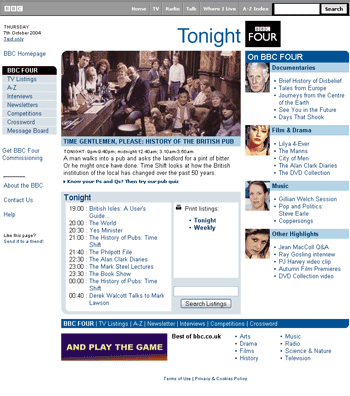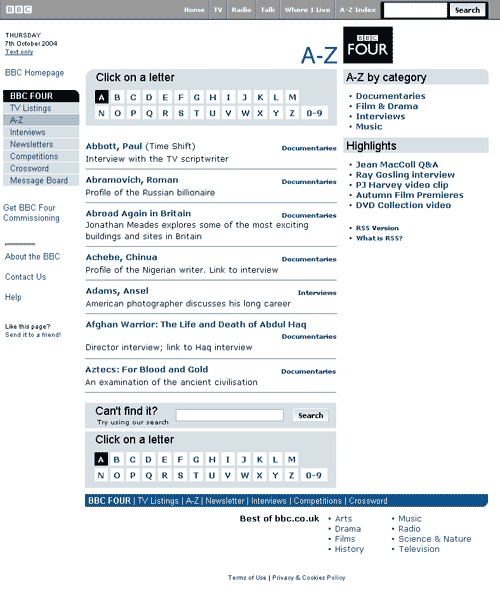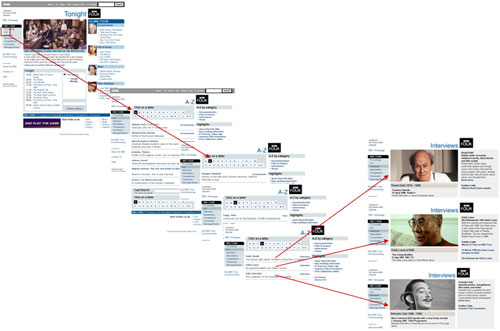Designing your website to be search engine friendly - part 3
This is page 3 of a 5 page article - 1 2 3 4 5
![]() Download a print version of this article
Download a print version of this article
Navigational Structures
The second technique to ensuring that your site is well represented in search engines that I would like to examine is to ensure that you build navigational structures that support the ability of search engines to index your site.
An example of how to do this embedded in the design of the BBC Four site on bbc.co.uk. BBC Four is a digital only channel in the UK, specialising in Arts and Documentary programming. The website supports this by carrying features on programmes, and interviews with the producers and directors of the programmes shown. It also includes an extensive selection of audio interviews from the BBC archives which can be listened to online.

A 2004 redesign promoted the A-Z Index of the BBC Four site to be one of the major navigational features of the left-hand navigation. The link leads to the 'A' page of the index. From here there are clear links through to every letter of the alphabet (and, of course, a symmetry spoiling link to the awkward existence of television programmes like 1984 and 37 uses for a dead sheep which start with a numeric character)

Additionally each entry can be categorised into content genres, which include documentary, interview and music. For each of these sub-sets of the A-Z index there is a page, i.e. BBC Four Documentaries: D, BBC Four Music: M, BBC Four Interviews: W.
Incidentally, the BBC Four A-Z index is one of the increasing areas of the bbc.co.uk site where content is being made available in alternative formats - the BBC Four A-Z is available as an RSS feed, and there are corresponding feeds for each of the genres.
Each of the index pages in the main A-Z, or in the sub-genre A-Z pages contains a list of links that lead directly to the content. The net effect of this is that whether you are looking for an interview with Roald Dahl, the Dalai Lama or Salvador Dali, the navigation path to any content page on the BBC Four site is a maximum of three links from the BBC Four homepage.

This also means that the content is much easier for search engines to spider. The automated bots that compile their indexes have little difficulty in finding all of the content since they only have to follow three links. The structure of the site is broad in terms of the content available, but by organising it in this way we have made the site shallow in terms of depth. This can be very important in terms of getting indexed, since search engine spiders rarely penetrate through very deep navigational structures that involve lots of directories and folders.
Not only that, but the links through to the content all have meaningful anchor text - the text that the user clicks or selects to follow the link. One only needs to look at the Googlebomb joke "Miserable Failure" to see the value of anchor text linking.
The upside of this is that not only is it useful for search engines to get straight to the content they want to index - but it is incredibly useful for the human audience - since they are never more than three links away from browsing to any content.
This is a great illustration of how Search Engine Optimisation, Usability and Accessibility work together as a virtuous circle. Making all the content easy to find via an A-Z with descriptive anchor text links is good for SEO. Making all your links have meaningful anchor text is essential for good accessibility, and is also useful for your entire user base. Generally if you do one of these disciplines, SEO, accessibility and usability, well, you will have made strides in the other two - and if you do two disciplines well, you may well have achieved the third without expending any effort.
Clearly an A-Z is a type of site map, and site maps in general have fallen out of fashion on the web. There is no surprise in that, as the volume of content on the web has increased. Certainly if I had my own web site in 1997 it would have consisted of "Martin's Homepage", "Martin's Cool Links Page" and "Martin's Cool Picture Page". And inevitably a site map that had links to these three pages. Now a site map of currybetdotnet would run to hundreds and hundreds of links.
Site maps though, are spider food - they are not going to rank highly in search engines themselves, but they provide a valuable gateway for search engines to get at your granular content pages, and if one can be made for your site with a low maintenance overhead I would always recommend it.